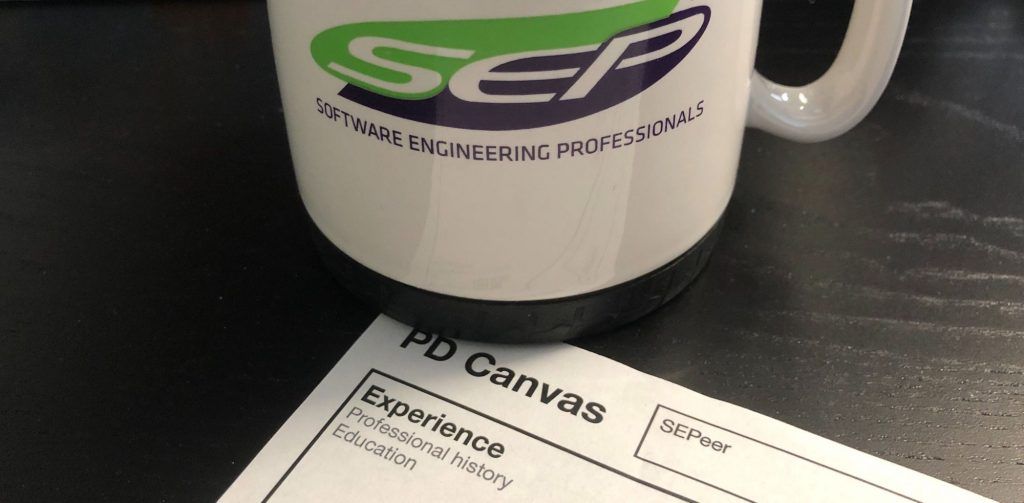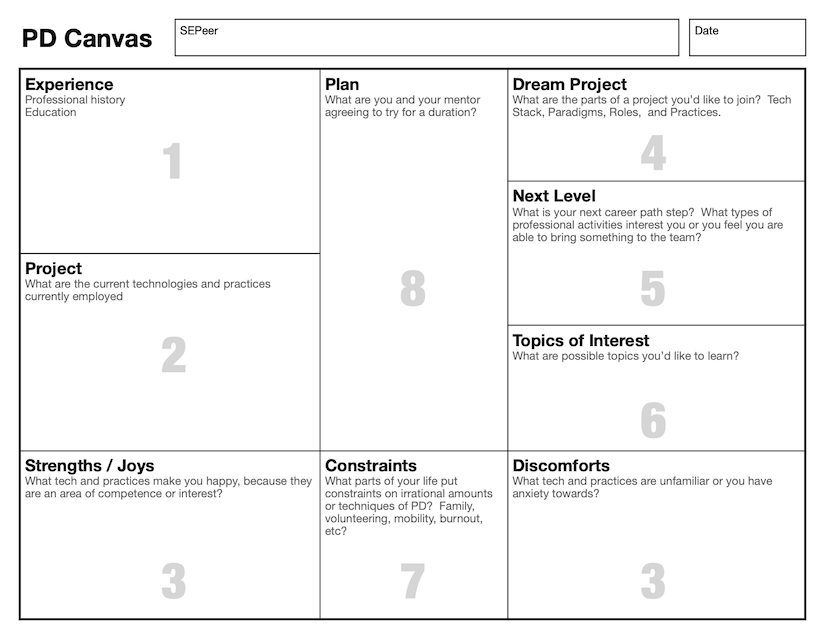
It is a developed skill to take all the different things in my life and answer two questions, “What should I learn next,” and “How am I going to learn it.” I’ve had twenty years to figure out how to self-direct my learning. In addition, I’ve had some semi-professional experience in developing my training materials and in helping my coworkers manage their own learning. So when I was asked to join an effort to help with technical mentorship of some of our SEPeers, I tried to figure out the best way to distill my experience into something that might help.
After running some ideas through a filter shaped like Chris Shinkle, SEP’s Director of Innovation, and Mike Rogers, a Lead Software Engineer with a passion for mentorship, I would like to present the Professional Development Canvas. While this canvas was created specifically with Software Developers / Engineers in mind, it should translate to other roles like Marketing Specialist or Data Analyst.
How to fill it out
Each field in the canvas has a number. They are meant to be filled out in order. Philosophically, they focus the conversation around where you are, where you want to go, and how you want to get there. But like all stories, strict linearity is not needed. If something comes up in the conversation, by all means, write it down! Edit and revise. It’s a scaffolding for a conversation. After explaining each field, I will share the results of walking through this with a colleague, Jordan Thayer.

1. Experience
Here is where to sketch out some education and professional experience. Do you have a non-standard educational experience you can leverage? Do you have experience from your professional past?
Jordan got their Phd in AI in 2012. She has professional experience writing static analyzers for JavaScript. She has also done code-rewriting and worked with automotive specifications.
2. Project
What is your current effort? What technology, practices, and domains are you currently working with? Often times, the needs of the current effort might be weighted a bit more heavily in your PD decisions than other concerns because you will, hopefully, see more immoderate payoff.
Jordan’s most recent efforts include AI training and Dev Evangelism. She has also worked on improving Fleet Management with AI/Data Analysis.
3. Strengths/Joys and Discomforts
These two boxes are very subjective. Does a stack or practice excite you? Do you ‘bounce-off’ of a language or area hard? Is something more difficult than it should be? Do you feel like you’re missing knowledge that should be obvious?
Jordan’s strengths are AI, ability to work with formal processes, and public speaking. Their joy comes from a variety of work.
Their history writing console applications lead to a discomfort with modern Web applications and UI/UX decisions. Their current work highlights some growth in Team Leadership and Management topics.
4. Dream Project
Close your eyes and envision what a dream project would look like. What is the kind of job or project you would quit your current job and move half-way around the country to be a part of? Is it because of how the team works? Is it because of field in which one works? Do you want to write mobile apps? Do no-estimate/kanban? Be elbow deep in AWS and DevOps? Cure cancer? Help hospice patients better manage pain? Write games?
Jordan’s currently living the dream. She wants to build AI capabilities and practices here at SEP and for our customers.
5. Next Level
What do you see as the next step in your career? Not 10 years out, but one or two. What skills need sharpening? What Roles and Functions are you performing? How will your day-to-day be different?
Jordan is choosing to focus on their current role instead of preparing for the next.
6. Topics of Interest
Is your curiosity piqued by a new trend, language, or framework? Do you have a hobby that is adjacent? Perhaps public speaking, counseling, coaching, digital audio, vector art, or home automation?
Jordan is interested in Business / team leadership topics. Particularly, estimation and client relations. Technically, she is interested in Machine Learning, Computer Vision, and Natrual Language Processing.
7. Constraints
If there were more hours in a day, we’d all spend them learning for our profession, I’m sure. But there aren’t and we are people who live in a context. Do you care for a child? Do you have volunteer commitments to a church or other organization? Do you have a chronic illness or injury that takes time or energy? Do you live off the grid with bad WiFi? Are you just burnt out from all the other stuff?
Jordan has a family and enjoys spending time with their wife and daughter.
8. The Plan
Now that you’ve put all the other information on the table, you can pick what and how. Look at the what and ask yourself, is this interesting or useful enough for me to follow through? Now, measure the how against your context and ask, “Can I actually do this?” Can you find time to take a college course? Can you afford developer licensing and required hardware? Can you find time to read a book?
Jordan was already prepping to host a book club based on “AI for Healthcare.” In addition, she will consider one of the following books, “The Team that Managed Itself,” “Lean Estimation,” or “Resonate” as she has highlighted an interest in the non-technical side of his work.
Professional Development is important. For SEP, our developer’s growth serves to make us stronger and more marketable to our customers. For our SEPeers, our knowledge, skills, and history is what we have to take with us beyond this company.
Build awesome things for fun.
Check out our current openings for your chance to make awesome things with creative, curious people.
You Might Also Like